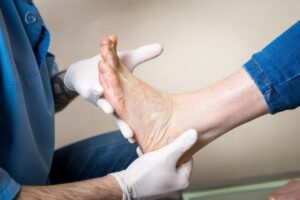
The feet are one of the most common areas for injuries and problems. However, many foot issues can be prevented with regular care and attention.
Proper hygiene, regular checkups, wearing the right shoes and exercise are essential for good foot health. Learn how to maintain your foot health and prevent common issues like bunions, hammertoes, ingrown toenails and athlete’s foot.
Proper Hygiene
The foot is an amazing creation with 26 bones, 33 joints, and 100 muscles, tendons, and ligaments all working together to get you from point A to B. But it’s also subject to the highest rate of injury and often the first place for systemic problems, such as gout or diabetes, to manifest.
Keep your feet clean and dry by washing them daily in lukewarm water with mild soap. Then, make sure to dry thoroughly, especially between the toes. Trim your toenails regularly, but be careful not to cut them too short, as this can lead to ingrown toenails. Also, be sure to file away rough corners and edges.
Exercise improves circulation in the feet and legs, so try to take walks daily. Also, wear shoes that offer support and cushioning and avoid going barefoot. In addition, be sure to use sunblock when at the beach or wearing sandals. Lastly, don’t overexert yourself when doing chores around the house; pushing your body too hard can cause injuries.
Get Regular Checkups
The human foot is a marvel of biomechanical engineering that most people take for granted until something goes wrong. A visit to a podiatrist can help you stay on top of your foot health, avoid serious issues, and keep your feet looking and feeling great.
It’s important to know your feet, including what they look like, so you can catch problems as soon as they arise and get them addressed before they turn into major issues that can stop you from doing what you want to do. Check your feet daily for cuts, blisters, redness, sores, or any areas that are a different color or texture. Check between your toes as well, and always wear shoes that fit properly and allow for proper air circulation.
Regular checkups with a podiatrist are especially important for those who have chronic health conditions, such as diabetes, which can lead to severe problems in the feet and ankles if not treated early on.
Wear the Right Shoes
Wearing the right shoes is critical. Whether you’re an athlete or just walking to work, it’s important to have the right shoes for your foot type, stance and activity level. Shoes should provide protection, support, stability and cushioning. It’s also important to replace shoes as soon as you start noticing signs of wear, which can cause damage over time.
Any physical activity, even a gentle stroll, puts strain on your feet and legs. And if your shoes don’t fit well, it can lead to foot conditions, such as bunions, heel pain and shin splints.
Make sure you try on shoes and walk in them before buying. Always buy for the larger foot, and remember that most people have one foot that’s bigger than the other. It’s also a good idea to choose shoes that don’t require a break-in period. And don’t be tempted to wear your old shoes until they literally fall apart.
Take Care of Your Feet
Regardless of your age or health status, taking good care of your feet is essential. Foot problems such as hammertoes, bunions, corns and calluses, ingrown toenails, and toenail fungus are not only uncomfortable, but can also limit your ability to perform daily activities. In addition, foot conditions may be the first signs of a more serious health issue such as gout or diabetes.
It’s easy to keep your feet healthy by following a few simple guidelines. Wash your feet regularly with lukewarm water and soap, and make sure to dry them thoroughly—particularly between the toes. Trim your toenails straight across and leave them a little longer than the tips of your toes to avoid ingrown nails. Try to avoid sitting with crossed legs for long periods of time and exercise your feet by walking or wriggling them around for five minutes several times per day to help promote circulation. Lastly, remember to visit your podiatrist regularly for a full exam of your feet and proper diagnosis and treatment when needed.